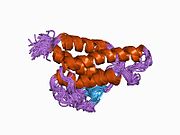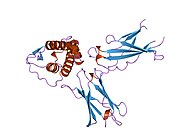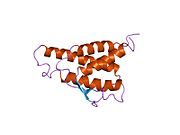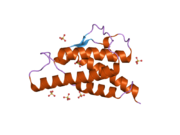Interleukin 4
| Interleukin 4 | |||||||||
|---|---|---|---|---|---|---|---|---|---|
| |||||||||
The interleukin 4 (IL4, IL-4) is a cytokine that induces differentiation of naive helper T cells (Th0 cells) to Th2 cells. Upon activation by IL-4, Th2 cells subsequently produce additional IL-4 in a positive feedback loop. IL-4 is produced primarily by mast cells, Th2 cells, eosinophils and basophils.[4] It is closely related and has functions similar to IL-13.
Function
Interleukin 4 has many biological roles, including the stimulation of activated
Overproduction of IL-4 is associated with
Inflammation and wound repair
Receptor
The receptor for interleukin-4 is known as the
Structure
IL-4 has a compact, globular
Evolution
IL-4 is closely related to IL-13, and both stimulate type 2 immunity.[11] Genes of this family have also been found in fish, both in bony fish[12][13] and cartilaginous fish;[14] because at that evolutionary level they can't be distinguished as IL-4 or IL-13, they have been named IL-4/13.[13]
Discovery
This cytokine was co-discovered by Maureen Howard and William E. Paul[15] as well as by Ellen Vitetta and her research group in 1982.
The nucleotide sequence for human IL-4 was isolated four years later confirming its similarity to a mouse protein called B cell stimulatory factor-1 (BCSF-1).[16]
Animal studies
IL-4 has been found to mediate a crosstalk between the neural stem cells and neurons that undergo neurodegeneration, and initiate a regeneration cascade through phosphorylation of its intracellular effector STAT6 in an experimental Alzheimer's disease model in adult zebrafish brain.[17]
Clinical significance
IL-4 has also been shown to drive
Illnesses associated with IL-4
IL-4 plays an important role in the development of certain immune disorders, particularly allergies and some autoimmune diseases.
Allergic diseases
Allergic diseases are sets of disorders that are manifested by a disproportionate response of the immune system to the allergen and Th2 responses. These pathologies include, for example, atopic dermatitis, asthma, or systemic anaphylaxis. Interleukin 4 mediates important pro-inflammatory functions in asthma, including induction of isotype rearrangement of IgE, expression of vascular cell adhesion molecule 1 (VCAM-1), promoting eosinophilic transmigration through endothelium, mucus secretion and T helper type 2 (Th2) leading to cytokine release. Asthma is a complex genetic disorder that has been associated with IL-4 gene promoter polymorphism and proteins involved in IL-4 signaling.[20]
Tumors
IL-4 has a significant effect on tumor progression. Increased IL-4 production was found in breast, prostate, lung, renal cells and other types of cancer. Overexpression of IL-4R has been found in many types of cancer. Renal cells and glioblastoma modify 10000–13000 receptors per cell depending on tumor type.[21]
IL-4 can primitively motivate tumor cells and increase their apoptosis resistance by increasing tumor growth.[22]
Nervous system
Brain tissue tumors such as astrocytoma, glioblastoma, meningioma, and medulloblastoma overexpress receptors for various growth factors including epidermal growth factor receptor, FGFR-1 (fibroblast growth factor receptor 1), TfR (transferrin receptor), IL-13R. Most human meningiomas massively expresses IL-4 receptors, indicating its role in cancer progression. They express IL-4Rα and IL13Rα-1-1, but not the surface γc chain, suggesting that most human meningiomas express IL-4 type II.[23]
HIV
IL-4 may also play a role in the infection and development of HIV disease. Auxiliary T cells are a key element of HIV-1 infection. Several signs of immune dysregulation such as polyclonal B cell initialization, previous cell-mediated antigen-induced response and hypergammaglobulinaemia occur in most HIV-1 infected patients and are associated with cytokines synthesized by Th2 cells. Increased IL-4 production by Th2 cells has been demonstrated in people infected with HIV.[24]
See also
References
- ^ a b c GRCm38: Ensembl release 89: ENSMUSG00000000869 – Ensembl, May 2017
- ^ "Human PubMed Reference:". National Center for Biotechnology Information, U.S. National Library of Medicine.
- ^ "Mouse PubMed Reference:". National Center for Biotechnology Information, U.S. National Library of Medicine.
- PMID 23087426.
- PMID 9392697.
- Lay summary in: "Scientists Identify Strong Genetic Link To Allergies". EurekAlert.org (Press release). December 10, 1997.
- ISBN 978-1-4160-3121-5.
- PMID 22538865.
- PMID 15464449.
- PMID 1993171.
- ^ S2CID 2310949.
- PMID 26044597.
- PMID 17084456.
- ^ S2CID 24675205.
- S2CID 4447611.
- PMID 6985399.
- PMID 3016727.
- PMID 27760324.
- PMID 21536546.
- PMID 26070934.
- PMID 11686867.
- PMID 27165851.
- PMID 18974110.
- S2CID 42324572.
- S2CID 39431866.
Further reading
- Zhu H, Wang Z, Yu J, Yang X, He F, Liu Z, et al. (July 2019). "Role and mechanisms of cytokines in the secondary brain injury after intracerebral hemorrhage". Progress in Neurobiology. 178: 101610. S2CID 85495400.
- Apte SH, Baz A, Groves P, Kelso A, Kienzle N (November 2008). "Interferon-gamma and interleukin-4 reciprocally regulate CD8 expression in CD8+ T cells". Proceedings of the National Academy of Sciences of the United States of America. 105 (45): 17475–17480. PMID 18988742.
- Kay AB, Barata L, Meng Q, Durham SR, Ying S (1997). "Eosinophils and eosinophil-associated cytokines in allergic inflammation". International Archives of Allergy and Immunology. 113 (1–3): 196–199. PMID 9130521.
- Marone G, Florio G, Petraroli A, de Paulis A (January 2001). "Dysregulation of the IgE/Fc epsilon RI network in HIV-1 infection". The Journal of Allergy and Clinical Immunology. 107 (1): 22–30. PMID 11149986.
- Marone G, Florio G, Triggiani M, Petraroli A, de Paulis A (2001). "Mechanisms of IgE elevation in HIV-1 infection". Critical Reviews in Immunology. 20 (6): 477–496. PMID 11396683.
- Maeda S, Yanagihara Y (October 2001). "[Inflammatory cytokines (IL-4, IL-5 and IL-13)]". Nihon Rinsho. Japanese Journal of Clinical Medicine. 59 (10): 1894–1899. PMID 11676128.
- Izuhara K, Arima K, Yasunaga S (September 2002). "IL-4 and IL-13: their pathological roles in allergic diseases and their potential in developing new therapies". Current Drug Targets. Inflammation and Allergy. 1 (3): 263–269. PMID 14561191.
- Copeland KF (December 2005). "Modulation of HIV-1 transcription by cytokines and chemokines". Mini Reviews in Medicinal Chemistry. 5 (12): 1093–1101. PMID 16375755.
- Olver S, Apte S, Baz A, Kienzle N (April 2007). "The duplicitous effects of interleukin 4 on tumour immunity: how can the same cytokine improve or impair control of tumour growth?". Tissue Antigens. 69 (4): 293–298. PMID 17389011.
- Sokol CL, Chu NQ, Yu S, Nish SA, Laufer TM, Medzhitov R (July 2009). "Basophils function as antigen-presenting cells for an allergen-induced T helper type 2 response". Nature Immunology. 10 (7): 713–720. PMID 19465907.
- Sokol CL, Chu NQ, Yu S, Nish SA, Laufer TM, Medzhitov R (July 2009). "Basophils function as antigen-presenting cells for an allergen-induced T helper type 2 response". Nature Immunology. 10 (7): 713–720. PMID 19465907.
External links
- Interleukin-4 at the U.S. National Library of Medicine Medical Subject Headings (MeSH)
- Interleukin-4 from Gentaur
- Recombinant Human Interleukin-4 from Cornell University
- Interleukin-4 from Allergy Glossary at Health On the Net Foundation
- Overview of all the structural information available in the PDB for UniProt: P05112 (Interleukin-4) at the PDBe-KB.




















